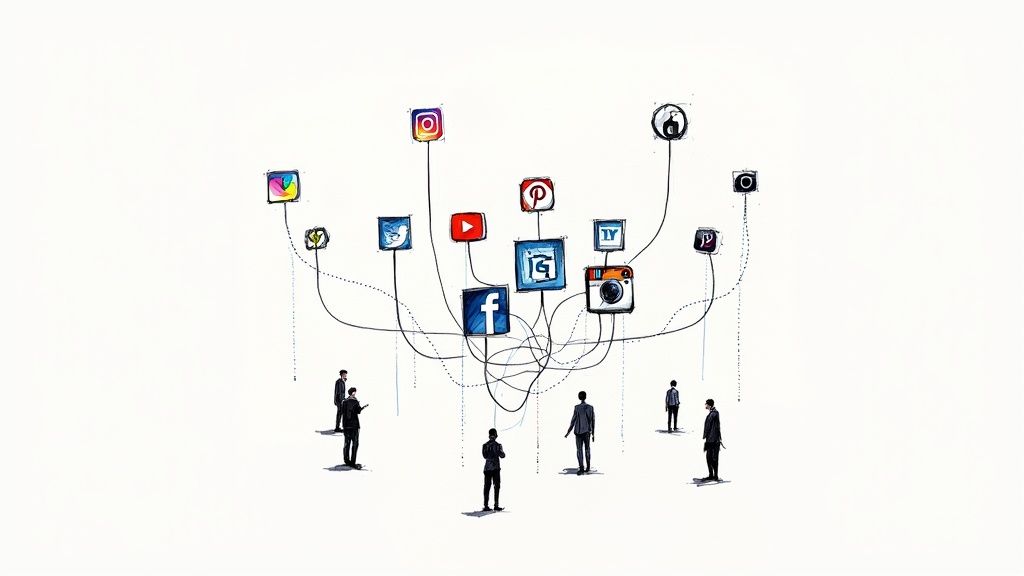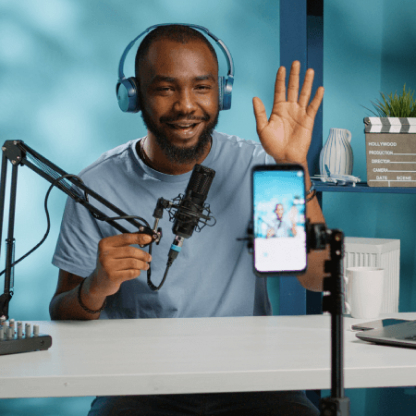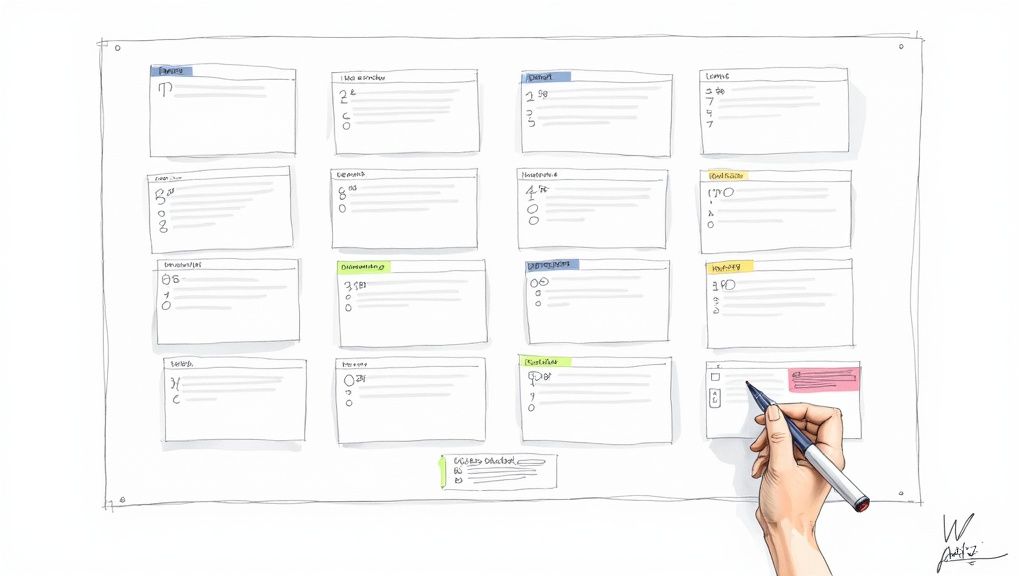Alright, let's have a frank conversation. You've posted on every job board known to humanity, sifted through a mountain of resumes that look suspiciously similar, and maybe even considered mortgaging the office ping-pong table for a bigger recruiting budget. The problem isn't your effort; it's the outdated playbook everyone else is using. Turns out there’s more than one way to hire elite talent.
It's time to talk about what actually moves the needle. We’ve been in the trenches, we've made the mistakes, and we've distilled it all down to the 10 genuine recruitment marketing strategies that separate the fast-growing teams from the perpetually-hiring ones. This isn't some theoretical HR lecture. We’re getting into the nitty-gritty of employer branding, content marketing that doesn't put people to sleep, and using data to make smarter bets on talent.
Forget the buzzwords and vague theories. This is a no-nonsense guide filled with actionable steps you can implement today. Ready to stop posting and start attracting the right people? Let’s get to it.
1. Employer Branding: Your Reputation is Your Best Recruiter
Let’s be honest, your company’s reputation walks into the room long before your recruiter does. Employer branding isn’t about slapping a mission statement on your careers page and calling it a day. It’s the constant, grinding work of defining and broadcasting what makes your company a place people actually want to work. This is the bedrock of all recruitment marketing strategies because it creates an inbound talent pipeline that money can't buy.

Think of it as the difference between cold-calling a candidate and having them knock on your door, resume in hand. Companies like Netflix didn't just stumble into a talent magnet status; they meticulously crafted it with their famous culture deck. Salesforce did the same with its "Ohana" culture, creating a narrative so compelling that people want to be a part of it.
How to Make It Work
Your employer brand already exists, whether you’re managing it or not. The goal is to take control of the narrative before someone else does.
- Start with an Internal Audit: Before you can sell your culture, you need to know what it actually is. Conduct anonymous employee surveys to get the real scoop on what people value (and what they roll their eyes at).
- Tell Authentic Stories: Ditch the corporate jargon. Showcase real employee testimonials, day-in-the-life videos, and behind-the-scenes content. Authenticity attracts candidates who will actually thrive in your environment.
- Align Brand with Reality: Ensure your external messaging matches the internal employee experience. Nothing kills an employer brand faster than a new hire realizing the "work-life balance" was just a marketing gimmick.
2. Social Media Recruitment: Fishing Where the Fish Are
Gone are the days when a LinkedIn post was the beginning and end of social recruiting. Today, it’s about meeting candidates where they live online, whether that's on Instagram, TikTok, or some niche Twitter community for data scientists. Social media recruitment is the art of using these platforms not just to post jobs, but to build a magnetic presence that attracts both active and passive candidates. It’s a powerful addition to your recruitment marketing strategies because it turns doom-scrolling into sourcing.

Think about it: you’re not just broadcasting a job ad into the void; you're joining an ongoing conversation. Companies like Marriott nailed this by using their Facebook Careers page to showcase employee stories, making a massive global brand feel personal. GE famously used Instagram to show off its jet engines and innovative tech, making heavy engineering look cool enough to attract top graduates. This isn’t just posting; it’s building a community.
How to Make It Work
Diving into social media without a plan is like shouting into the wind. You need to be strategic and authentic to cut through the noise. To understand the broader context of social media in business, exploring general social media marketing strategies can be highly beneficial.
- Tailor Content to the Platform: What works on LinkedIn (professional achievements, industry insights) will die a painful death on TikTok. Use Instagram for visual storytelling, Twitter for quick-hit conversations and industry news, and Facebook for community building.
- Leverage Employee-Generated Content (EGC): Nobody trusts a corporate recruiting ad. A photo from a team outing shared by an actual employee? That’s gold. Encourage and reshare content from your team to provide an authentic, unfiltered look at your culture.
- Engage, Don’t Just Broadcast: Social media is a two-way street. Respond to comments, answer questions in DMs, and participate in relevant industry hashtags. Prompt and genuine engagement shows you’re listening and that there are real people behind the brand.
3. Content Marketing for Talent Acquisition
If your careers page is just a list of job openings, you’re doing it wrong. Content marketing for talent acquisition is about playing the long game. Instead of just shouting "we're hiring," you're creating valuable, relevant content that showcases your company's expertise and culture, attracting candidates who are aligned with your mission before they even think about applying. This is one of the most effective recruitment marketing strategies because it builds a community, not just a candidate pool.

Think of companies like HubSpot. They don't just post jobs; their career blog is a treasure trove of content on professional development, company culture, and industry insights. Buffer takes it a step further with radical transparency, openly sharing everything from salary formulas to diversity stats. They're not just filling roles; they're building a brand that top talent actively seeks out.
How to Make It Work
Great content turns passive observers into active candidates. It's your chance to show, not just tell, why your company is the place to be.
- Create Candidate Personas: You can’t create compelling content if you don’t know who you’re talking to. Define your ideal candidates: What are their career goals? What challenges do they face? What content do they consume?
- Repurpose, Repurpose, Repurpose: Don't let a great blog post die on your website. Turn it into a Twitter thread, a LinkedIn carousel, a short video, or even a podcast segment to maximize its reach across different channels.
- Include a Clear Call-to-Action (CTA): Every piece of content should guide the reader somewhere. Whether it's to join your talent network, follow your company on LinkedIn, or check out a relevant job opening, make the next step obvious and easy.
4. Employee Referral Programs: The Ultimate Insider Endorsement
Who do you trust more: a slick job ad or a friend who says, “My company is hiring, and you’d be perfect for it”? Your employees are your most credible brand ambassadors, and a structured referral program turns their networks into a high-quality talent pipeline. This isn't just about getting more resumes; it’s about getting pre-vetted, culturally aligned candidates who already have a trusted source on the inside.
The $500 Hello.

This is one of the most effective recruitment marketing strategies because it leverages pure, unadulterated trust. Tech giants have perfected this, with Google famously offering significant bonuses and Dropbox seeing referrals as a key growth driver. They understand that a recommendation from a current high-performer is worth more than a dozen cold applications. Referred employees often have higher retention rates, faster onboarding times, and a better cultural fit from day one.
How to Make It Work
A great referral program is more than just a cash bonus. It's about creating a simple, rewarding, and transparent process that encourages participation.
- Make it Effortless: Don’t make employees jump through bureaucratic hoops. Use a simple, mobile-friendly system where they can submit a name and a LinkedIn profile in under a minute. The more friction you add, the fewer referrals you’ll get.
- Offer Rewards People Actually Want: While cash is king, it isn’t the only option. Consider extra vacation days, tech gadgets, or donations to a charity of their choice. Providing options makes the program more inclusive and appealing.
- Communicate, Communicate, Communicate: Keep the referring employee in the loop. Let them know when their candidate has been contacted, interviewed, and hired. Celebrate successes publicly to remind everyone of the program's value and show you appreciate their efforts.
5. Recruitment Marketing Automation: Stop Doing the Busywork
If you're still manually sending follow-up emails to every silver-medalist candidate, you’re not a recruiter, you’re a professional copy-paster. Recruitment marketing automation uses technology to handle the repetitive, time-sucking tasks that clog your calendar, like nurturing talent pools and scheduling social posts. This isn’t about replacing recruiters with robots; it’s about freeing them up to do what they do best: build relationships and close candidates.
This is one of those recruitment marketing strategies that pays for itself in sanity alone. Platforms like Beamery and iCIMS automate communication workflows, ensuring no promising candidate ever feels ghosted. It’s the difference between a leaky bucket and a well-oiled talent pipeline. You maintain consistent, personalized contact with hundreds of potential hires without lifting a finger for each individual message.
How to Make It Work
Automation's goal is to scale your personal touch, not eliminate it. It’s about being thoughtful at scale, so you can focus on the conversations that truly matter.
- Start Simple, Then Scale: Don't try to build a ten-stage, multi-channel nurturing sequence on day one. Start with a simple automated "thanks, but not this time" email that directs unsuccessful applicants to your talent community.
- Personalize with Dynamic Content: Use tokens like
[First Name]and[Job Title]to make automated messages feel less, well, automated. A little personalization goes a long way in keeping your communication human. - Keep a Human in the Loop: Automation should handle the follow-ups, but a human should handle the conversation. The moment a candidate replies with a question or shows renewed interest, a real person needs to step in immediately.
6. Talent Community Building: Stop Fishing, Start Farming
Why spend your days cold-calling candidates when you can have an engaged audience waiting for your next move? Talent community building is the strategic practice of nurturing a network of potential candidates who are already interested in your company, even when you don't have an open role. It’s one of the most effective recruitment marketing strategies for playing the long game.
Think of it this way: instead of desperately casting a net every time you need to hire, you’re cultivating a farm. Salesforce has mastered this with its Trailblazer Community, creating a loyal ecosystem that feeds its talent pipeline. General Electric does the same with specialized communities for engineers, keeping top minds engaged long before a job requisition is ever approved.
How to Make It Work
A talent community is more than just an email list; it's a living, breathing network that requires genuine investment.
- Provide Value Beyond Job Postings: No one wants another newsletter full of job alerts. Share exclusive industry insights, offer access to webinars, or create networking opportunities. Give them a reason to stay engaged.
- Segment Your Audience: Don't send your backend engineering content to your marketing prospects. Segment your community by role, skill set, or location to deliver hyper-relevant information that keeps them interested.
- Create Ambassador Programs: Identify the most engaged members of your community and empower them to become brand ambassadors. They can provide valuable feedback and become your most credible source for referrals.
- Streamline Your Engagement: Nurturing a community takes time, but modern tools can help. You can modernize your recruitment process with on-demand asynchronous interviews, allowing you to connect with community members efficiently and on their schedule. Learn more about modernizing your recruitment process with on-demand asynchronous interviews.
7. Programmatic Job Advertising: Let the Robots Do the Bidding
Still manually posting jobs on a dozen different boards and hoping for the best? It’s 2025. Programmatic job advertising automates this entire messy process, using AI to buy, place, and optimize your job ads in real-time. It’s the difference between blindly throwing darts and using a laser-guided system to hit the bullseye every single time. This is one of the most powerful recruitment marketing strategies for companies that need to maximize their ad spend and reach the right candidates, not just the most candidates.
Think of it as the stock market for job ads. Platforms like PandoLogic and Appcast use algorithms to bid on ad space across countless sites, targeting specific candidate demographics and behaviors. It automatically shifts your budget to the channels delivering the best applicants, so you stop wasting money on job boards that just don't perform. To fully grasp the power of this strategy, it's helpful to understand what programmatic advertising is and how it functions in today's digital landscape.
How to Make It Work
Diving into programmatic can feel intimidating, but it’s really about setting clear rules for the machine to follow.
- Define Your Victory Conditions: Before you start, know what a "win" looks like. Is it a lower cost-per-application, a higher volume of qualified leads, or a faster time-to-hire? Give the AI a clear target to aim for.
- Optimize Your Job Descriptions: Your job descriptions are the creative for your ad campaigns. Ensure they are clear, compelling, and keyword-optimized so the algorithms can match them to the right audience on any platform.
- Trust, But Verify: While the system is automated, it’s not a "set it and forget it" tool. Regularly monitor performance dashboards to see which channels and ads are converting. Be ready to tweak your budget and targeting rules based on what the data tells you.
8. Candidate Relationship Management (CRM)
Great candidates don't just appear when you have an open role; they need to be nurtured over time. A Candidate Relationship Management (CRM) system is your secret weapon for playing the long game. It’s a systematic approach to managing relationships with potential hires, tracking every interaction, and keeping your talent pool warm and engaged, even when you aren't actively hiring for their specific role. This is one of the most proactive recruitment marketing strategies available.
Think of it this way: you wouldn't just discard a sales lead because they aren't ready to buy today, would you? The same logic applies to talent. A recruitment CRM, like those offered by Beamery or Phenom People, allows you to build a private talent community. Instead of starting from scratch with every new job req, you can tap into a curated pipeline of candidates who already know and admire your brand.
How to Make It Work
A CRM is only as good as the strategy behind it. Don't let it become a digital resume black hole.
- Segment Your Talent Pools: Go beyond just job titles. Create detailed candidate personas and segment your talent pools by skill set, experience level, location, and even their level of engagement with your content.
- Automate, but Stay Human: Use automation for sending relevant content, company updates, or even birthday wishes. But ensure a real person steps in for meaningful interactions. The goal is relationship-building, not just email blasting.
- Practice Good Data Hygiene: A messy CRM is a useless CRM. Establish clear rules for data entry and regularly clean your database to ensure information is accurate and up-to-date. To ensure your Candidate CRM truly works for you, consider adopting some of these broader essential lead management best practices.
9. Video Recruitment Marketing: Show, Don't Just Tell
Let's be real: a block of text describing your "dynamic, fast-paced culture" is about as exciting as an unread privacy policy. Video recruitment marketing cuts through the corporate jargon and gives candidates an authentic, engaging look inside your company. It’s the difference between reading the description of a concert and actually being there. This strategy is essential because it builds an emotional connection that a job description simply can't.
Think about the raw, behind-the-scenes content that brands like Slack share. They aren’t just listing perks; they’re showing their teams collaborating, solving problems, and genuinely enjoying their work. Similarly, Shopify's day-in-the-life videos give candidates a far more realistic job preview than any bulleted list of responsibilities ever could. It’s a powerful tool to attract candidates who are a true cultural fit, not just a keyword match.
How to Make It Work
Great video isn't about a Hollywood budget; it's about authenticity. Your goal is to give candidates a real window into your world, not a polished-to-perfection commercial.
- Embrace the Unscripted: Ditch the teleprompter. Capture genuine employee testimonials, team meeting snippets, and casual office tours. A slightly shaky phone video of a team celebrating a win often feels more real and compelling than a high-production shoot.
- Optimize for Mobile and Brevity: Most candidates will see your videos on their phones while scrolling through social media. Keep them short (under 90 seconds), vertically formatted, and add captions for accessibility and silent viewing.
- Create a Series, Not a One-Off: Don't just make one "culture video" and call it a day. Build a content series around different teams, roles, or company values. This keeps your content fresh and allows you to showcase various aspects of your organization over time.
10. Data-Driven Recruitment Analytics
Gut feelings are great for picking lunch spots, but they’re a terrible way to build a world-class team. Data-driven recruitment analytics is the practice of replacing guesswork with hard numbers. It involves systematically tracking, analyzing, and applying recruitment data to see what’s actually working, what’s a waste of money, and where your best candidates are hiding. This is one of the most critical recruitment marketing strategies for scaling effectively and proving ROI.
Think of it this way: you wouldn't run a sales campaign without a CRM, so why run your hiring funnel blind? Google’s legendary people analytics team famously used data to optimize everything from interview questions to team composition. Likewise, platforms like LinkedIn Talent Insights give companies a powerful lens into talent pools, helping them make strategic decisions instead of just posting and praying.
How to Make It Work
You don’t need a PhD in statistics to get started, you just need to be intentional about what you measure and why. Stop drowning in vanity metrics and focus on what moves the needle.
- Define Your North Star Metrics: Don't track everything. Start with a few crucial KPIs that align directly with business goals, like cost-per-hire, time-to-fill, or quality of hire. If you're unsure where to begin, explore some essential recruitment KPIs to get started.
- Ensure Data Integrity: Garbage in, garbage out. Regularly audit your data sources (like your ATS) to ensure information is accurate and consistently entered. A messy database will only lead to messy conclusions.
- Build a Reporting Cadence: Data is useless if it just sits there. Create a simple weekly or monthly dashboard for your team to review. Discuss trends, celebrate wins, and diagnose problems before they spiral out of control.
Recruitment Marketing Strategies Comparison Matrix
| Strategy | Implementation Complexity 🔄 | Resource Requirements ⚡ | Expected Outcomes 📊 | Ideal Use Cases 💡 | Key Advantages ⭐ |
|---|---|---|---|---|---|
| Employer Branding | High 🔄🔄 | High ⚡⚡ | Long-term reputation building, talent attraction 📊📊 | Large organizations aiming for competitive talent edge 💡 | Lowers cost-per-hire, improves retention, strong EVP ⭐⭐ |
| Social Media Recruitment | Medium 🔄 | Medium ⚡ | Reach passive candidates, varied engagement 📊 | Broad talent outreach, active engagement on platforms 💡 | Cost-effective, precise targeting, real-time communication ⭐⭐ |
| Content Marketing for Talent Acquisition | High 🔄🔄 | High ⚡⚡ | Builds thought leadership, sustained candidate interest 📊 | Companies focused on inbound talent attraction 💡 | Establishes industry authority, SEO benefits, measurable ROI ⭐⭐ |
| Employee Referral Programs | Low to Medium 🔄 | Low to Medium ⚡ | Higher quality hires, faster fills 📊 | Organizations with strong internal networks 💡 | Better cultural fit, lower cost, faster hiring ⭐⭐⭐ |
| Recruitment Marketing Automation | High 🔄🔄 | Medium to High ⚡⚡ | Scaled consistent candidate communication 📊 | Businesses needing efficiency in repetitive tasks 💡 | Increases productivity, detailed analytics, scalable ⭐⭐ |
| Talent Community Building | Medium to High 🔄🔄 | Medium ⚡⚡ | Pipeline of engaged candidates, brand loyalty 📊 | Companies investing in long-term candidate relationships 💡 | Pre-qualified talent pool, market insights, reduces time-to-hire ⭐⭐ |
| Programmatic Job Advertising | High 🔄🔄 | Medium to High ⚡⚡ | Optimized ad spend, increased visibility 📊 | Large-scale hiring with complex ad management needs 💡 | Maximizes ROI, multi-platform reach, reduces manual effort ⭐⭐ |
| Candidate Relationship Management (CRM) | High 🔄🔄 | High ⚡⚡ | Improved candidate experience, efficient talent pool management 📊 | Large enterprises managing ongoing candidate engagement 💡 | Personalized communication, data insights, lowers time-to-hire ⭐⭐ |
| Video Recruitment Marketing | Medium 🔄 | Medium to High ⚡ | Higher engagement, authentic culture showcase 📊 | Brands targeting younger, video-native candidates 💡 | Engaging content, repurpose across channels, authentic storytelling ⭐⭐ |
| Data-Driven Recruitment Analytics | High 🔄🔄 | Medium to High ⚡⚡ | Evidence-based hiring decisions, process optimization 📊 | Organizations focusing on continuous recruitment improvement 💡 | Identifies bottlenecks, measures ROI, predictive insights ⭐⭐ |
So, What's the Magic Bullet?
Spoiler alert: there isn't one. If anyone tries to sell you a single, cure-all solution for your hiring woes, they’re probably also selling beachfront property in Kansas. The real secret isn't finding one magic bullet; it's building a hiring machine.
We’ve walked through ten powerful recruitment marketing strategies, from building an irresistible employer brand to diving deep into data analytics. Standing alone, each is a useful tool. A strong referral program can bring in a few great hires. A slick video campaign might boost your application numbers for a quarter. But when you treat them as isolated tactics, you’re just playing whack-a-mole with your hiring needs.
The true breakthrough comes when you see these strategies not as a checklist, but as interconnected gears in a powerful recruitment flywheel.
Building Your Recruitment Flywheel
Think of it this way: a powerful Employer Brand (Strategy #1) is the core of your flywheel. It’s the energy source. You then use authentic Content Marketing (Strategy #3) and engaging Social Media (Strategy #2) to broadcast that brand identity, attracting candidates who resonate with your mission.
This consistent outreach populates your Talent Community (Strategy #6) and your Candidate Relationship Management (CRM) system (Strategy #8). Now, you’re not just posting and praying. You’re nurturing a warm audience of potential hires.
When a role opens up, you don’t start from scratch. You tap into your community and activate your supercharged Employee Referral Program (Strategy #4). For broader reach, you deploy targeted Programmatic Job Advertising (Strategy #7) that’s smarter and more efficient because it’s informed by your brand and content.
All of these moving parts are held together by Recruitment Marketing Automation (Strategy #5), which keeps the process humming without burning out your team. And how do you know if it's all working? You rely on Data-Driven Analytics (Strategy #10) to measure, tweak, and optimize every gear in the machine.
The goal is to stop being reactive and start being strategic. It’s about creating a system where great candidates are consistently flowing into your orbit, pre-sold on why they should work for you long before a job is even posted. This integrated approach to recruitment marketing strategies is what separates the companies that land A-players from those who are perpetually stuck hoping the right resume shows up.
So, stop searching for a magic bullet. Start building your machine. The best candidates aren’t waiting for you to figure it out.
Ready to streamline a critical part of your hiring machine? Async Interview helps you automate initial screenings with one-way video interviews, freeing up your team to focus on building relationships and executing the high-impact recruitment marketing strategies that matter. Start reclaiming your time with Async Interview.




